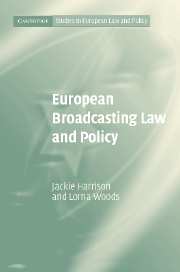Book contents
- Frontmatter
- Contents
- Series Editors' Preface
- Preface
- Case list
- PART I
- PART II
- 6 Access
- 7 Media ownership: impact on access and content
- 8 Jurisdiction, forum shopping and the ‘race to the bottom’
- 9 Advertising placement and frequency: balancing the needs of viewers and commercial interests
- 10 Negative content regulation
- 11 Positive content regulation: quotas
- 12 Privatisation of sport and listed events
- 13 State aid: constraints on public service broadcasting
- PART III
- Appendix
- Bibliography
- Index
6 - Access
Published online by Cambridge University Press: 29 July 2009
- Frontmatter
- Contents
- Series Editors' Preface
- Preface
- Case list
- PART I
- PART II
- 6 Access
- 7 Media ownership: impact on access and content
- 8 Jurisdiction, forum shopping and the ‘race to the bottom’
- 9 Advertising placement and frequency: balancing the needs of viewers and commercial interests
- 10 Negative content regulation
- 11 Positive content regulation: quotas
- 12 Privatisation of sport and listed events
- 13 State aid: constraints on public service broadcasting
- PART III
- Appendix
- Bibliography
- Index
Summary
Introduction
Any discussion about the need for content regulation presupposes that viewers are able to receive that content. Access to content depends on access to infrastructure and transmission/reception technologies; a fact we have noted in our discussion of the environmental factors affecting the viewing experience (chapter 1). Although reception equipment is required to be able to view any form of television, with the advent of cable and satellite transmission technologies we see the introduction of conditional access systems (CAS), enabling pay TV. CAS creates the tollgate, allowing access to programming for only those who pay. In this, we see technology playing a part in the commodification and the commercialisation of the broadcasting environment.
The Union response to the policy challenges relating to access to content has combined two types of regulation. Ex ante sector-specific regulation, which seeks to attain public interest objectives and safeguard the position of the citizen (rather than the viewer as a consumer); and ex post, which is a general competition-based approach focusing on the operation of the market. Implicitly, a market-based approach is linked to a conception of communication as private property rather than a public resource. Combined with these, and further complicating matters, is the issue of infrastructure standards adopted by the Union, which is reliant on industry involvement. This is an approach that is replete with problems arising from the interplay of Union and member-state competence, the impact of commercialisation and the clash between industry interests and viewer needs.
- Type
- Chapter
- Information
- European Broadcasting Law and Policy , pp. 115 - 145Publisher: Cambridge University PressPrint publication year: 2007

